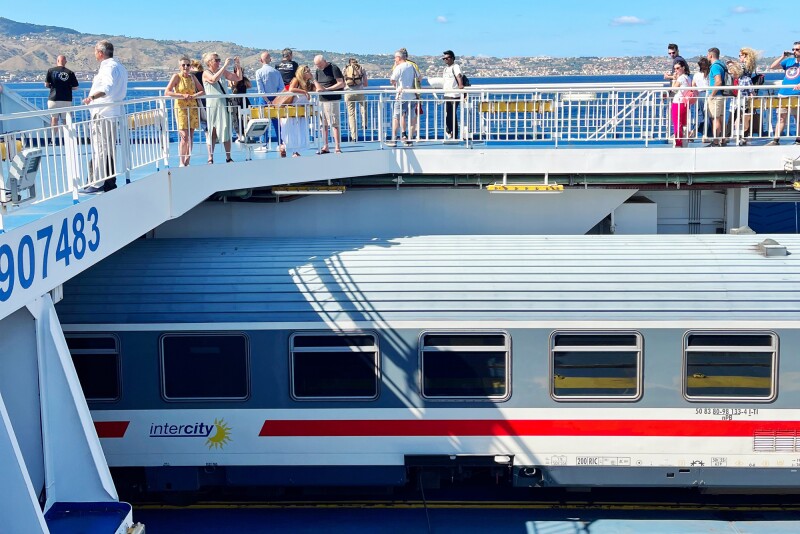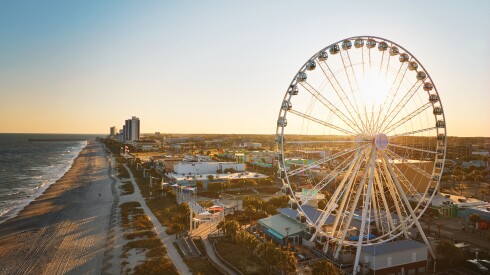Every year, approximately 11 million people cross the Strait of Messina between mainland Italy’s southernmost region and the island of Sicily. They travel via a robust ferry system that also transports vehicles, and there’s also a train-to-ferry option, a picturesque slow-travel route that shuttles train carriages across the channel aboard specially designed ferries.
However, the recent approval of a €13.5 billion (about $15.7) plan to build a bridge connecting Sicily and Italy’s Calabria, the region at the tip of Italy’s boot, could drastically change transportation across this nearly two-mile strait—and transform both regions in the process. Whether that’s for the better depends on whom you ask.
What is the bridge project between Sicily and mainland Italy?
Projected to be completed between 2032 and 2033, the Strait of Messina Bridge would become the world’s longest single-span suspension bridge. As reported by Reuters, the project’s supporters (who include Italy’s transport minister Matteo Salvini) claim that the bridge will boost economic development, increase tourism to both regions, and lower the cost of goods in Sicily.
Critics cite high economic and environmental costs and the risk of corruption and mafia involvement, according to various English- and Italian-language news reports, including CNN, the Associated Press, and the New York Times. Then there’s the potential for natural disasters: The area is part of an active seismic zone at risk for earthquakes.
In a press conference announcing the project on August 6, Salvini called the bridge “an accelerator for development” in southern Italy, claiming that it will reduce the time needed to cross the strait from about 30 minutes to about 15 and eliminate occasional bottlenecks and delays during disembarkation. The news was quickly followed by protests in which thousands of bridge opponents marched through Messina.
If the bridge does come to fruition, the 2.3-mile span would be held up by two 1,309-foot towers (one in Sicily and one in Calabria), meaning they would be taller than the Eiffel Tower, according to Webuild, the leading company in the project. The plans include two roadways with three lanes each and two central railway tracks, which could make the need for ferries obsolete—and offer another environmental benefit, according to Salvini. “If there are no longer thousands of ferries going back and forth, polluting the sea, but instead there are trains that do not pollute, there will be less pollution in the water,” he told Gazzetta della Sicilia in 2023.
In response to the August 6 announcement, Legambiente, an Italian environmental nonprofit, released a statement calling Salvini’s declarations political propaganda and noting that the Corte dei Conti, Italy’s legislative body tasked with controlling public spending, has yet to approve the project.
The plan still needs to be approved by various environmental agencies, both at the national and EU levels, as noted by the BBC. Environmental groups have already filed a complaint with the European Union, citing serious risks for the local environment, according to the Guardian.
Angelo Bonelli, a member of the Italian Chamber of Deputies and spokesperson for Green Europe, a political party dedicated to climate-neutral policies, is among the project’s strongest critics. In an August 6 post on X, Bonelli slammed the project’s high costs and environmental impact, calling it a “colossal waste of public money.”
Southern Italy’s train-to-ferry route to Sicily could be replaced by the bridge

A proposed suspension bridge connecting Italy and Sicily has been approved by Italy’s government, which could also mean the end of a train-to-ferry route.
Photo by Laura Itzkowitz
The idea of connecting Sicily to mainland Italy by bridge is not new. “Throughout history, the dream of connecting the two shores has been a temptation as persistent as the smoke drifting from [Mount] Etna’s crater,” Rome-based journalist Eric J. Lyman wrote in his Substack, the Italian Dispatch, noting that Pliny the Elder wrote about plans to build a floating bridge of barges as early as the first century.
Many others entertained the idea over the course of the centuries, but no one—including the late former Italian prime minister Silvio Berlusconi—has managed to do it yet.
For now, travelers and transportation enthusiasts who want to experience the peaceful strait crossing can book tickets on Intercity trains via Italy’s state-run railway operator, Trenitalia. Trains from mainland Italy depart from Rome and pass through Naples, Salerno, and a handful of other towns before boarding the ferry in Villa San Giovanni and crossing the Strait of Messina to eastern Sicily, at which point they split into separate lines running to Palermo or Siracusa. Tickets start at €34.90 ($40.85) one way, and the total train journey takes between one and eight hours, depending on where you board the train.
For some passengers, the transition from train to ferry is the highlight. Several times per day, Intercity trains in Italy slowly roll onto tracks embedded into the lower deck of a ferry as workers in yellow vests and hard hats survey the scene. Once the train is safely on board, its doors open and passengers disembark, climbing to the ferry’s upper deck, where they might enjoy an espresso or snack at the bar. Others sit on blue plastic seats or stand against the railing, watching Sicily come into view.
This feat of engineering marks one of two train-to-ferry routes remaining in Europe, according to Rail Europe: The only other route of this kind is a crossing between northern Germany and southern Sweden. The Maritime Archeology Trust notes that there were once at least 127 train ferries around the world, and now there are 23. However, an article on its website argues that bridges and tunnels have rendered “many of them obsolete"—a fate that could fall upon this special journey across this channel in the Mediterranean Sea, if the long-debated bridge is built. But, for the time being, travelers still have the chance to enjoy this memorable train-and-ferry journey.








